Post by 90GTVert on Apr 29, 2011 8:51:21 GMT -5
First off, let me start by outlining the process of making a pass to get a spark plug chop, or reading. Reading is more accurate for most of us. The term plug chop is used because some tuners will actually cut or chop part of the spark plug off in order to get a good look at it. Some people say it's called a plug chop because you "chop" off the ignition or throttle at the end of your pass. Whatever you prefer to call it, here's how I do it...
Interpreting the spark plug is the tricky part. I'm no expert. I'm just offering you a look at how I now read lugs.
The only time I pay a much attention to a spark plug reading is at WOT. I tend to only look at a spark plug for part throttle for a basic guideline to show me if I'm way off.
When I read a spark plug for WOT, I am looking at the mixture ring. The bottom of the porcelain insulator, where it meets the steel part of the plug is where you see the mixture ring, as illustrated below.
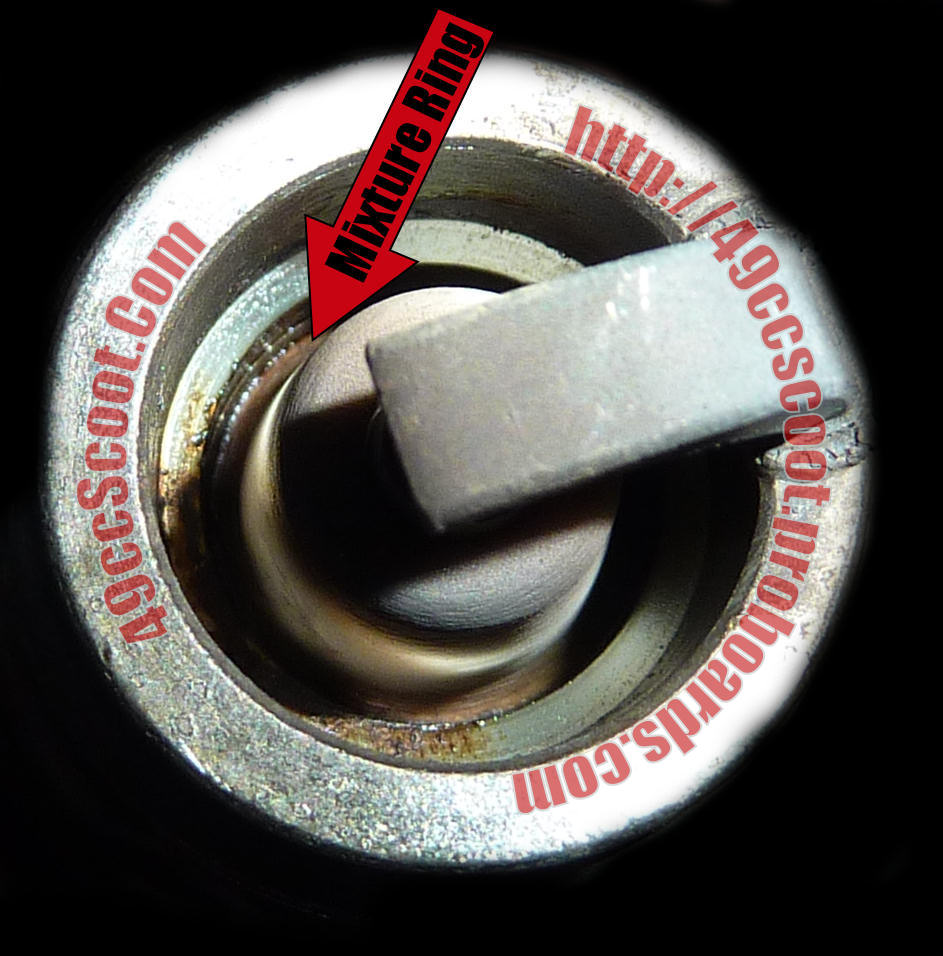
You will need a lot of light to see the mixture ring well. Taking the spark plug into sunlight works quite well. A small flashlight can be quite handy. A lighted magnifying glass is supposed to be very good for viewing plugs. The fact that this can be so hard to see is actually why spark plugs are "chopped" apart by some. Below is a plug that I "chopped" so you can clearly see what you are looking for.
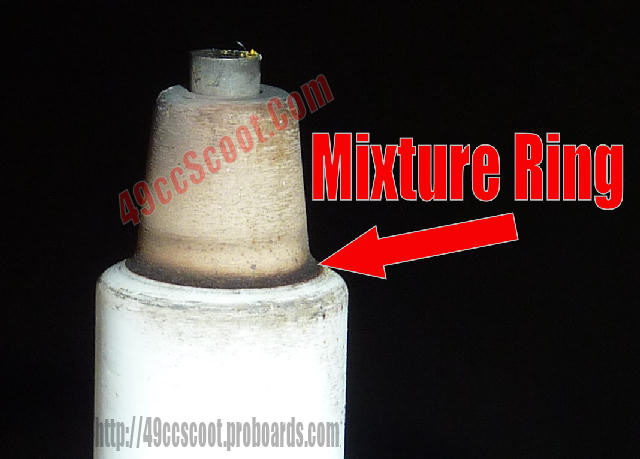
Be sure you are looking at the correct thing. The images below illustrate why lots of light and possibly magnification is important. In the first image, it kind of looks like there's a dark mixture ring on the porcelain. The second pic shows that same plug cut apart.
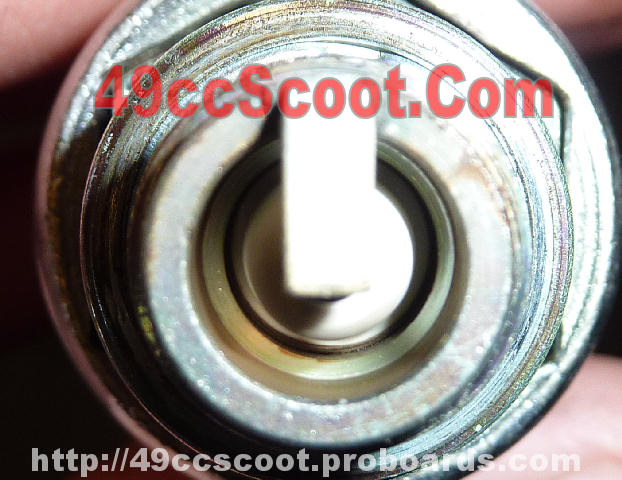
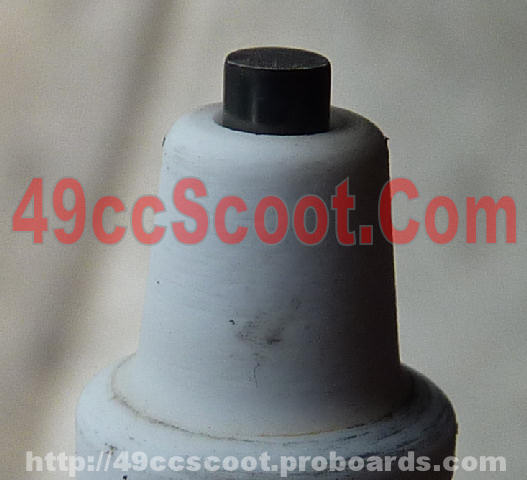
If you'd like to cut your plug apart to read it, it's simple. Cut it right where you see it cut in the photo below. You can use a hacksaw, sawzall, cutoff wheel, dremel, etc... Just make a cut around the ring, right before the hex portion of the plug. Once that's free, you can remove the metal from the plug.
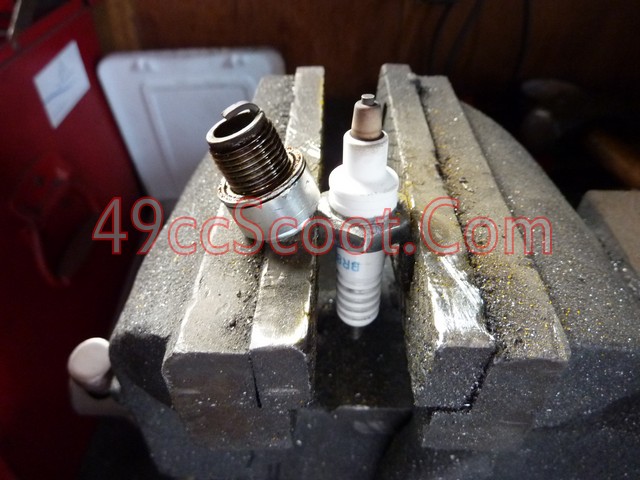
The mixture ring should be dark in color and a couple of mm thick. A very thin or light mixture ring usually indicates a lean condition. A very thick mixture ring that creeps up farther toward the tip of the insulator is an indicator of a rich condition. I find that plugs tend to be wet in appearance before the mixture ring gets much thicker than the images above.
The picture below shows a rich plug with a thin mixture ring, but a wet appearance. (Ignore the debris in that image. It's leftover from sawing the plug apart.) Excess fuel tends to wash out he mixture ring.
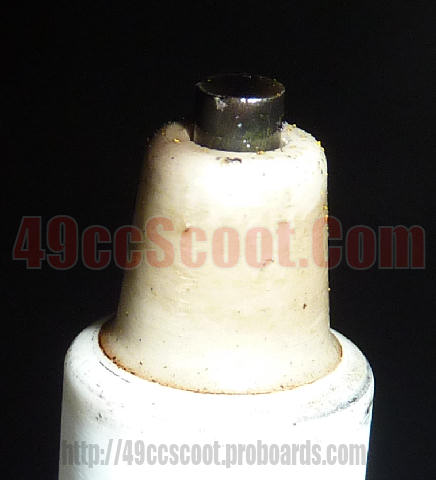
The image below shows a spark plug from an engine running a bit lean, but making good power. Notice how thin the dark bit of the ring is.
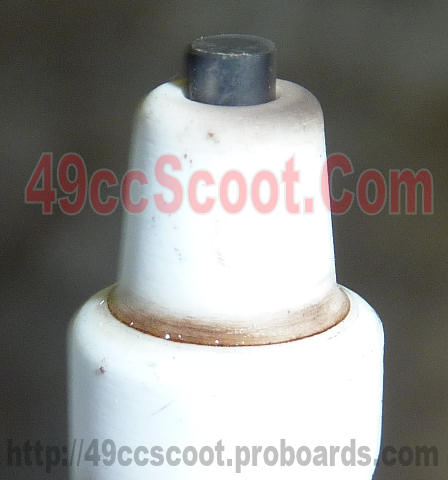
The plug below is even leaner than the one above.
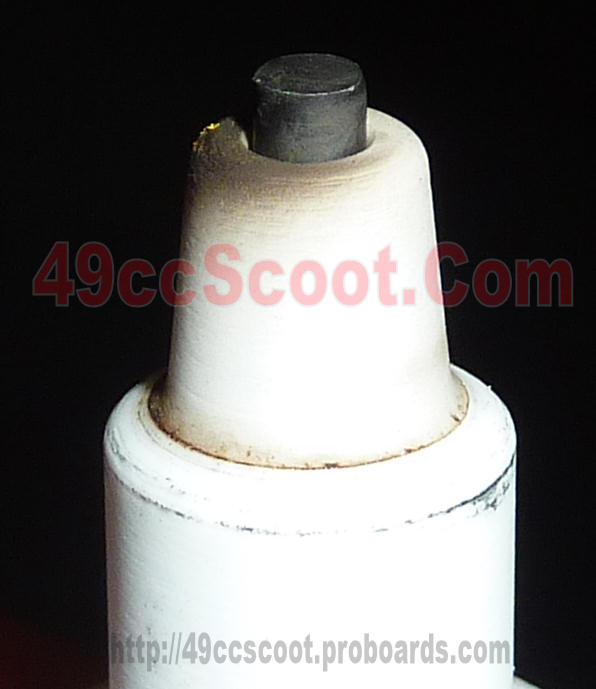
The above plug readings are from an air cooled two-stroke. Four-strokes and liquid cooled two-strokes may be able to get away with leaner tunes than the air cooled two-stroke. Tunes for drag racing may be able to be leaner if greater power is achieved, since runs should be brief.
- Before you start, make sure you can access the spark plug for a quick change. If panels need to be removed, do so. Only remove what you can safely take a quick test ride without. In most cases, you should be able to reach the plug without removing much of anything.
- Install an old or previously used spark plug. You don't want the engine's idle and warm up time to color the plug you'll be reading.
- Start the scooter and warm up the engine to operating temperature. If using an automatic enricher (like most stock scooters) be sure to allow plenty of time for it to close off the enrichment circuit. This should happen within about 3 minutes in most cases. If using a manual choke, turn it off when you can.
- While waiting for the engine to warm up, get a new spark plug and the tools necessary to do the swap ready and place them by the scoot. The plug doesn't necessarily have to be new, but it needs to be clean and white. I like to have any gear I'll want for the test ride on, other than gloves usually.
- Once the engine is warm and not being enriched or choked, shut it off.
- Change the spark plug to the new one as quickly as you can, of course being careful not to burn yourself or damage anything in the process. Take what time you need to do it right, but don't delay.
- Put on whatever gear you need to ride, that you aren't already wearing, and hop on the scooter.
- Start the scooter once you are ready to ride. Avoid idling or other non tuning related riding the best you can.
- The goal on your ride is to stay at the throttle position you wish to check (usually wide open throttle WOT) as much as possible. This should not be a leisurely ride, but rather a ride with a purpose. Choose an area with little to no traffic if at all possible. Maybe even plan to do this at a time when you know there is less traffic. Just don't annoy your neighbors and get yourself in trouble at 2AM. You don't need to go far. I like to at least 1/2 mile of the throttle position for a chop. Longer is fine, but it can often be hard to stay WOT for extended time periods.
- When you get close to your work area again (still maintaining the throttle position), turn off the ignition or kill switch to stop the engine. Since most scooters are CVT driven, the engine will tend to keep moving from the belt turning it over. You need to apply the brakes and stop as quickly as you feel is safe to get the engine to quit. If you have a scooter with a manual clutch, pull the clutch to disengage and the engine should die quickly. Coast in or push it back. Do not start it again until after you've checked the spark plug. After you've done this a few times, you'll learn where you need to kill it and brake to avoid pushing. Either that, or you'll get a lot of exercise.
- Now you should have a plug suitable for reading.
Interpreting the spark plug is the tricky part. I'm no expert. I'm just offering you a look at how I now read lugs.
The only time I pay a much attention to a spark plug reading is at WOT. I tend to only look at a spark plug for part throttle for a basic guideline to show me if I'm way off.
When I read a spark plug for WOT, I am looking at the mixture ring. The bottom of the porcelain insulator, where it meets the steel part of the plug is where you see the mixture ring, as illustrated below.

You will need a lot of light to see the mixture ring well. Taking the spark plug into sunlight works quite well. A small flashlight can be quite handy. A lighted magnifying glass is supposed to be very good for viewing plugs. The fact that this can be so hard to see is actually why spark plugs are "chopped" apart by some. Below is a plug that I "chopped" so you can clearly see what you are looking for.

Be sure you are looking at the correct thing. The images below illustrate why lots of light and possibly magnification is important. In the first image, it kind of looks like there's a dark mixture ring on the porcelain. The second pic shows that same plug cut apart.


If you'd like to cut your plug apart to read it, it's simple. Cut it right where you see it cut in the photo below. You can use a hacksaw, sawzall, cutoff wheel, dremel, etc... Just make a cut around the ring, right before the hex portion of the plug. Once that's free, you can remove the metal from the plug.

The mixture ring should be dark in color and a couple of mm thick. A very thin or light mixture ring usually indicates a lean condition. A very thick mixture ring that creeps up farther toward the tip of the insulator is an indicator of a rich condition. I find that plugs tend to be wet in appearance before the mixture ring gets much thicker than the images above.
The picture below shows a rich plug with a thin mixture ring, but a wet appearance. (Ignore the debris in that image. It's leftover from sawing the plug apart.) Excess fuel tends to wash out he mixture ring.

The image below shows a spark plug from an engine running a bit lean, but making good power. Notice how thin the dark bit of the ring is.

The plug below is even leaner than the one above.

The above plug readings are from an air cooled two-stroke. Four-strokes and liquid cooled two-strokes may be able to get away with leaner tunes than the air cooled two-stroke. Tunes for drag racing may be able to be leaner if greater power is achieved, since runs should be brief.
















